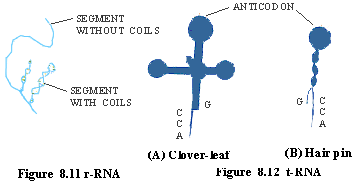|
PinkMonkey Online Study Guide-Biology
|
Table 8.2 : Difference between DNA and RNA |
| |
Characters |
DNA |
RNA |
|
1. |
Molecule |
Double stranded, helical |
Single stranded, straight or variously folded and twisted. |
|
2. |
Pentose sugar |
Deoxyribose |
Ribose |
|
3. |
Pyrimidine base |
Thymine |
Uracil |
|
4. |
Complementary base pairing |
Always present and exists between A = T and G = C |
Normally absent, but may be present in twisted segments of a molecule.
If present, pairing is between A = U and G = C |
|
5. |
Ratio of Purines: Pyrimidines |
Always 1 : 1 |
Not necessarily 1:1 |
|
6. |
Replication |
Can replicate |
Cannot replicate |
Types of non-genetic RNA and their functions
There are three types of non-genetic RNA.
(1) mRNA or messenger RNA, (2) rRNA or ribosomal RNA
and (3) tRNA or transfer RNA.
(1) mRNA (Messenger RNA) : This is called messenger RNA because it carries information for protein synthesis from the DNA to the ribosomes in the cytoplasm (the site of protein synthesis). m-RNA constitutes about 3-5% of the total RNA. It is produced on the DNA strand. The process is called transcription. Hence, the base sequence of mRNA is complementary to that of the DNA strand. The bases on the mRNA strand are organized into triplets. Each triplet consists of a sequence of three consecutive bases (nucleotides) and is called a codon (code word). Each codon specifies one amino acid. The sequence of codons on the mRNA strand is called the mRNA language. It indicates the sequence of amino acids for the synthesis of a protein. It begins with the codon AUG (initiation codon or starting codon) and ends with either UAA, UAG or UGA (stop codons). The single-stranded mRNA molecule is always straight (Fig. 8.10) and therefore, base pairing is totally absent in mRNA.
 <
Figure 8.10 m-RNA <
Figure 8.10 m-RNA
Role of # m-RNA in # protein # synthesis
-
Represents the sequence of codons from the DNA strand
(transcription).
Brings the sequence to the ribosomes (site of protein synthesis) in the cytoplasm. Provides the sequence for the synthesis of specific protein from the amino acids with the help of t-RNA (translation).
(2) rRNA (Ribosomal RNA) : r RNA forms about 80%
of the total RNA. It is present in the ribosomes in the cell cytoplasm
(site of protein synthesis) and hence called rRNA. The single-stranded
molecule of rRNA is variously folded and twisted upon itself in certain
regions (Figure 8.11). In such folded regions, complementary bases form
pairs and are joined by hydrogen bonds.
Role of rRNA in protein synthesis : The role of
rRNA in protein synthesis is not yet very clearly known but it is known
to complex with various protiens. The resulting structure is a ribosome,
and this complex reads the coded sequence in mRNA to link amino acids
together into particular protiens.
It provides proper binding sites for the mRNA of the ribosomes. It orients the mRNA in such a way that its nitrogen base triplets or codons are properly read or translated. It also releases tRNA after the transfer of activated amino acid. It protects the mRNA strand from the action of enzymes (nucleases). -
It protects the growing (nascent) polypeptide chain
from proteolytic enzymes.
(3) tRNA (Transfer RNA) : It is the smallest of
all the types of RNA. About 10 to 20% of the total RNA of the cell is
of this type. tRNA strand is folded upon itself forming loops. It results
in either a clover leaf pattern or hair pin pattern (Figure 8.12).
One end of the strand has guanine, while the other end carries
the CCA combination of nitrogen bases. A triplet of nitrogen bases called
anticodon is present on one of the loops. The anticodon pairs with
the complementary codon on the mRNA molecule. The tRNA molecules
carry amino acids to the mRNA during the process of protein synthesis.
Each type of the amino acid is carried by a specific tRNA molecule. tRNA
is synthesized on the DNA template. It has complementary base pairs in
folded regions.

Role of tRNA in protein synthesis
-
tRNA carries the required specific amino acids from
cell cytoplasm to the ribosome (site of protein synthesis).
-
Each type of amino acid is carried by a specific
type of tRNA.
-
In the ribosome, tRNA helps to arrange the amino
acids in their proper sequence for the synthesis of a protein. This
is done with the help of the codons on the mRNA and the matching (complementary)
anticodons on the tRNA (translation).
|